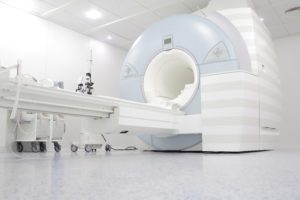Fluxgate for MRI
MRI (Magnetic resonance imaging) are widely used in medical imaging and are commonly found in hospital.
They rely on magnetic field to image the patient’s body, but are sensitive to external magnetic field disturbances which can affect the quality of the image. MRI manufacturers therefore have maximum magnetic field profile the ambient field distortions must be kept below.
In the event the field does not fit in the prescribed profile, there are mitigation actions which can be taken, including in the worst-case scenario active cancellation.
Finally, due to the strong magnetic field used in an MRI, safety of the patient within the MRI must be ensured by preventing any magnetic material from entering the MRI suite where it could be sucked in by the magnetic field and injure the patient.
We will review here the most suitable equipment to perform these different tasks.
MRI Site surveys
To ensure best images, it is essential that the ambient field around an MRI is kept within the manufacturer’s specifications.
In order to check the ambient field variations (both in DC/near DC and AC), a site survey needs to be carried out at the site where the MRI will be located. In order to be representative, the environment has to be within the same conditions as it will be during the MRI’s operation. That is, any nearby machinery, including elevators will need to be operating, and the same will be true for any vehicles that can move in the vicinity of the MRI.
Because both magnetic field and vibration can affect image quality, vibration measurements are also carried out on the finished floor where the MRI will be installed.
The Spectramag-6 was specifically designed for this type of work. Its ability to run a magnetometer together with accelerometers allow for joint recording of the magnetic field as well as vibration. The Mag-13MS1000 is the best suited magnetometer as its range of 1mT allow for both pre and post survey (5 Gauss line) should this be required.
Surveys are carried out at DC to monitor for local transient (elevators, vehicles, etc.) and at AC to monitor the amplitude of mains magnetic field or any other field generated by machinery. The use of survey parameters allows the user to program the maximum field excursion allowed by the manufacturer in both the AC and DC domains, and will trigger an alarm should these levels be exceeded.
The accelerometer inputs permit the connection of ICP accelerometers (up to 3) to record the vibrations.
In both cases (magnetic and vibrations), care should be taken during to survey to avoid anyone from moving in the vicinity of the sensing elements so as to not introduce artificially high distortion which wouldn’t be representative of normal operation.
The same technique can also be used for survey of electron microscope. Electron microscope uses a column of electron to image a sample. External magnetic field variations can lead to some oscillation of the electron beam and reduce the image quality. Ensuring that the instrument is installed in a quiet magnetic environment will help maintain performance.
Active cancellation for MRI
In the event the results from the site survey show excursions beyond the tolerated fields, there are some mitigation measures available. Passive shielding uses ferromagnetic materials to distort the magnetic field lines away from the area being protected.
In extreme cases, this is not sufficient, and an active cancellation system is required. In this situation a fluxgate sensor (such as the Mag-13MS1000 or similar) is placed within the room. The sensor’s output is used to monitor the ambient field, with the sensor’s output fed into the control system of a 3-axis coil system around the MRI room. When an external disturbance is detected, the output changes and this alter the current to the coils to counteract the disturbance detected. Commercial systems such as ETS Lindgren uses the Mag-03 for their cancellation system.
The same cancellation system can be used around electron microscope to maintain a stable field around the electron beam column. Here the coils can be a lot smaller and typically just encompass the upper part of the instrument which contains the electron beam.
MRI Suite Access control
Once an MRI is running, the DC field generated is on the order of several Tesla. Any ferromagnetic object entering the room could get sucked in the bore of the magnet and could injure the patient. By using magnetometers at the entrance of the MRI suite will help detecting ferromagnetic materials crossing the threshold of room will trigger an alarm warning personnel that they are carrying risky materials within the room.
A range of single and three-axis sensors offer low-cost options for OEM integration into a portal system.
Single-axis sensor options include the Mag670 (packaged) or the Mag646 and Mag710 (unpackaged). If a three-axis option is required, the Mag690, Mag612U and Mag619U are all suitable options. Single axis options will have the benefit in this application that they will be less influenced by ferromagnetic material passing in front of the door rather than trying to go through the door.

